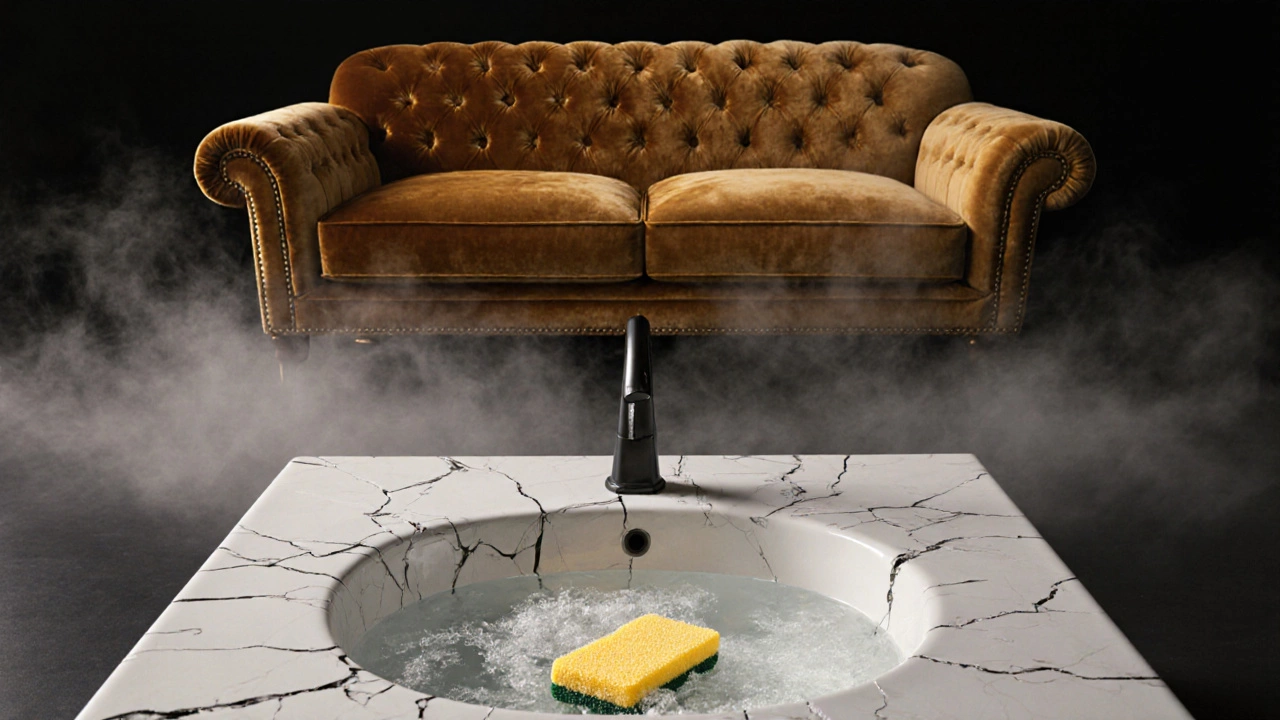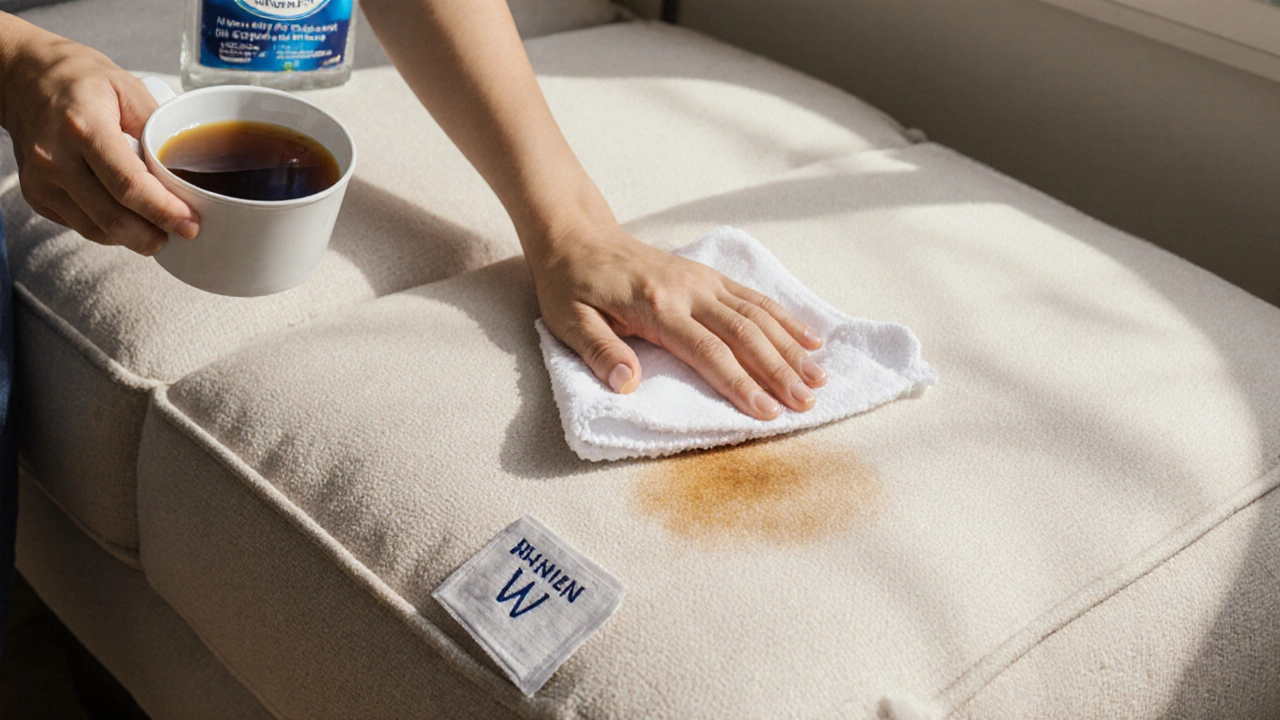You spilled coffee on your favorite sofa. Or your kid tracked in mud after soccer practice. Or your dog decided your couch was the perfect spot for a post-bath shake-off. Suddenly, you’re staring at a stained, damp mess-and wondering if that bottle of Dawn dish soap in the kitchen sink might save the day.
It’s a common question. Dawn is cheap, powerful on grease, and seems to work miracles on pans. So why not use it on fabric? The short answer: sometimes, yes-but only if you know exactly how, and only on certain fabrics. The long answer? It’s riskier than you think.
Why People Think Dawn Works on Upholstery
Dawn’s reputation comes from its grease-cutting power. It’s designed to break down oils and food residue on dishes. Since many upholstery stains-like cooking oil, butter, or body oils-are fatty, people assume the same chemistry will work on fabric.
And it’s true: many DIY cleaners mix Dawn with water and vinegar to tackle stains on carpets, car seats, and couches. Online videos show people scrubbing away red wine and pet accidents with a sponge and a few drops of Dawn. It looks easy. It looks effective.
But here’s what those videos don’t show: the aftermath.
The Hidden Risks of Using Dish Soap on Fabric
Dawn isn’t made for upholstery. It’s made for porcelain. And that difference matters.
First, dish soap leaves residue. Unlike laundry detergent, which is formulated to rinse clean from fibers, Dawn sticks around. That residue attracts dirt. A few days after you clean your sofa with Dawn, you’ll notice the spot looks even dirtier than before. It’s not the stain returning-it’s the soap acting like a magnet for dust and grime.
Second, Dawn can damage fabric dyes. Many upholstery fabrics are dyed with water-sensitive pigments. The surfactants in Dawn can pull color out of the fibers, especially on older or cheaper materials. You might end up with a faded, uneven patch where the stain used to be.
Third, over-wetting is a silent killer. Upholstery padding and frame materials don’t dry like a kitchen counter. If you soak the fabric too much, moisture gets trapped. That leads to mold, mildew, and that musty smell you can’t get rid of-even after cleaning.
A 2023 study by the Textile Care Research Institute tested 12 common household cleaners on 8 popular upholstery fabrics. Dawn ranked among the top three for causing color loss and residue buildup. It also took 40% longer to dry than specialized upholstery cleaners.
When Dawn Might Actually Be Safe
It’s not all bad news. There are situations where Dawn, used carefully, can help.
If your upholstery is made of 100% polyester or microfiber, and the manufacturer’s tag says “W” for water-based cleaning, then a diluted Dawn solution might be okay. But only if you follow these steps exactly:
- Test in an inconspicuous spot first-like under a cushion or on the back of the armrest.
- Use one drop of Dawn per cup of lukewarm water. That’s it. No vinegar. No baking soda. Just water and one drop.
- Dip a clean white cloth into the solution, then wring it out until it’s barely damp.
- Gently dab-not scrub-the stain. Work from the outside in to avoid spreading it.
- Immediately blot with a dry cloth to remove moisture.
- Repeat only if needed. Stop after two attempts.
- Let the area air-dry completely-no hair dryers, no heaters.
And even then, you’re gambling. This works best on fresh, non-oily stains-like soda spills or light mud. For grease, ink, or dried-on pet messes? Skip it.

What You Should Use Instead
There are far better, safer options designed specifically for upholstery.
For everyday spills, use a commercial upholstery cleaner labeled for your fabric type. Brands like Bissell, Woolite, or Resolve have formulas tested on common fabrics like cotton blends, linen, and synthetic weaves. They rinse cleanly, don’t leave residue, and are pH-balanced to protect dyes.
For a natural alternative, try a solution of one part white vinegar to two parts water. Vinegar breaks down organic stains without damaging most fabric dyes. Add a drop of castile soap (not Dawn) if you need extra cleaning power. Always test first.
For greasy stains, sprinkle baking soda on the area, let it sit for 15 minutes, then vacuum it up. Baking soda absorbs oil without wetting the fabric. It’s safe, cheap, and effective.
For deep cleaning, rent a steam cleaner from your local hardware store. Use only the manufacturer-recommended cleaning solution-never dish soap. Steam cleaning lifts dirt from deep in the fibers without soaking the padding.
How to Read Your Upholstery Care Label
Before you clean anything, check the tag. It’s usually hidden under a cushion or along the bottom edge of the frame. The codes tell you exactly what’s safe:
- S = Solvent only. Use only chemical cleaners. Water will damage it.
- W = Water-based cleaners only. Safe for diluted solutions like vinegar or upholstery cleaner.
- SW = Solvent or water. You have flexibility.
- X = Vacuum only. No liquids. No chemicals.
If the tag says “S” or “X,” don’t even think about Dawn. If it says “W” or “SW,” proceed with caution-and stick to purpose-made cleaners.

What Happens If You Already Used Dawn?
You’ve already cleaned your couch with Dawn. Now the fabric feels sticky. The stain looks worse. Or you notice a weird smell.
Don’t panic. Here’s what to do:
- Blot the area with a cloth soaked in plain water. Don’t scrub. Just press and lift.
- Repeat with a fresh, dry cloth to absorb moisture.
- Use a fan to speed up drying. Keep the area ventilated.
- If the fabric still feels sticky after 24 hours, mix a solution of one tablespoon of white vinegar in a cup of water. Dab lightly over the area to neutralize residue.
- Blot again with a dry cloth.
- If the stain remains or the fabric is discolored, call a professional. They have industrial extractors that can remove deep residue.
Professional cleaners use high-pressure extraction systems that pull out soap, dirt, and moisture in one pass. They’re worth the cost if you’ve already damaged the fabric.
Bottom Line: Skip the Dish Soap
Dawn dish soap is not a miracle cleaner for upholstery. It’s a kitchen tool that accidentally works on some stains-sometimes. But the risks outweigh the rewards.
It leaves residue. It fades colors. It traps moisture. And it can permanently ruin your furniture.
For safe, lasting results, use cleaners made for fabric. Test first. Blot, don’t scrub. Dry thoroughly. And when in doubt, call a pro.
Your sofa deserves better than a kitchen cleaner. So does your wallet-because replacing a ruined couch costs more than hiring a professional cleaner twice.
Can Dawn dish soap remove pet stains from upholstery?
Dawn can help with fresh pet urine or vomit if the fabric is labeled "W" and you use it correctly-one drop in a cup of water, dabbed gently. But it won’t remove odors. For that, you need an enzymatic cleaner that breaks down proteins. Dawn doesn’t touch odor-causing bacteria. Using it alone may leave a sticky, smelly mess that attracts more dirt and pets.
Is Dawn safe for microfiber couches?
Microfiber is often labeled "W," so a diluted Dawn solution can be used cautiously. But many microfiber fabrics have a water-repellent coating that Dawn can break down over time. This makes the fabric more prone to staining later. For microfiber, a dedicated upholstery cleaner or a vinegar-water mix is safer and just as effective.
Will Dawn damage colored upholstery?
Yes, it can. Dawn contains surfactants that can pull dye out of fabric fibers, especially on older, cheaper, or synthetic blends. Even if the stain disappears, you might be left with a faded or discolored spot. Always test in a hidden area first. If the color bleeds, stop immediately.
How do I know if my sofa can be cleaned with water?
Look for the care label under the cushions or along the frame. A "W" means water-based cleaners are safe. An "S" means only solvent cleaners. An "X" means no liquids at all. If there’s no label, assume it’s "S" or "X"-it’s safer to avoid water. Most modern sofas are made from blends that don’t handle water well.
What’s the best way to clean upholstery without buying products?
For light stains, mix one part white vinegar with two parts water. Dab with a clean cloth, then blot dry. For grease, sprinkle baking soda, let sit 15 minutes, then vacuum. For odors, sprinkle baking soda, wait overnight, then vacuum. These methods are safe, cheap, and don’t leave residue. Always test first.
